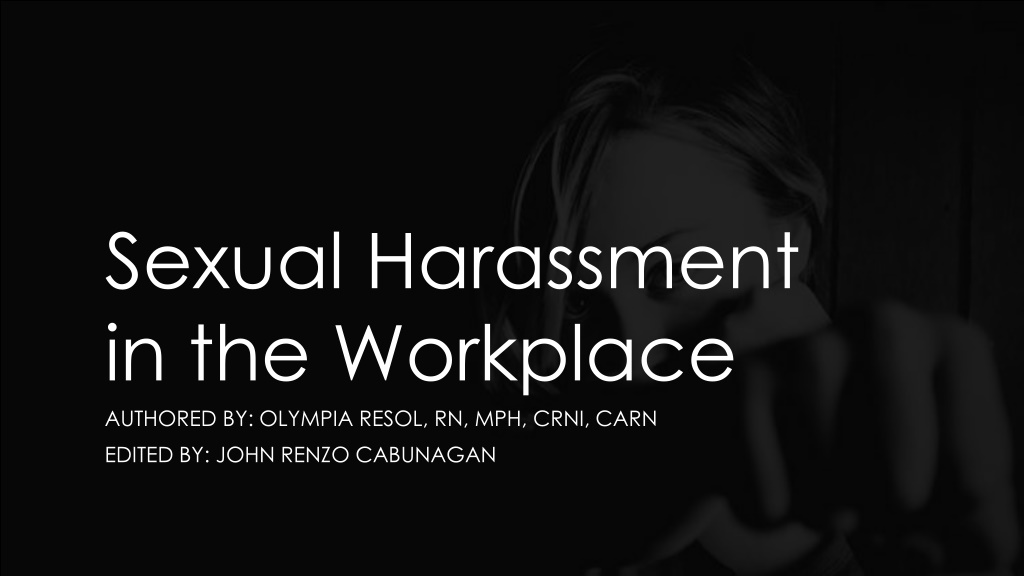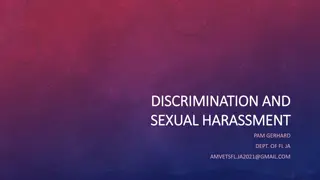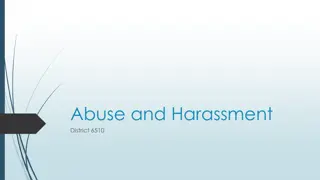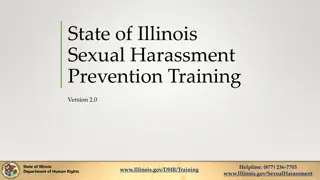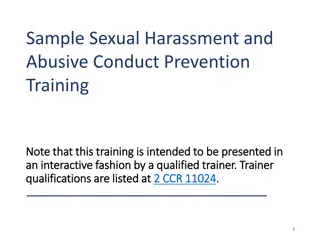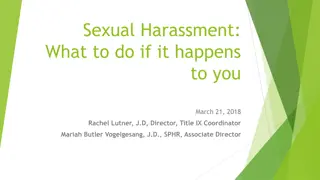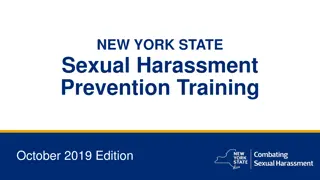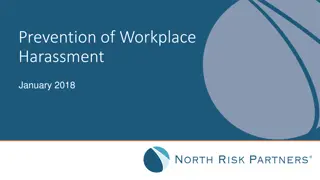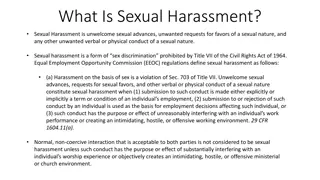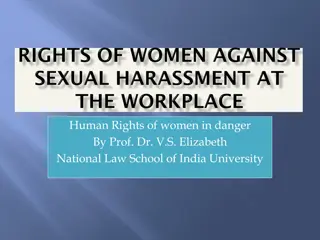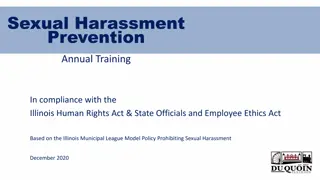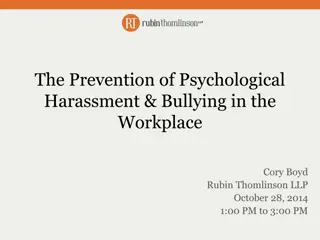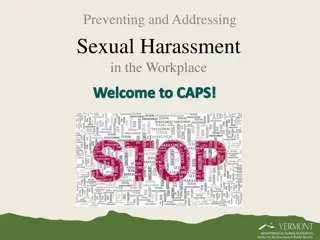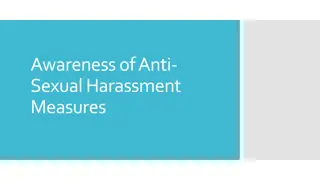Addressing Sexual Harassment in the Workplace
This education program aims to equip ARF administrators with the knowledge and skills to prevent, recognize, and address sexual harassment in the workplace. Through learning objectives such as defining sexual harassment, understanding federal mandates, reporting procedures, and intervention strategies, administrators can create a safer work environment. The scenario presented highlights the importance of identifying and taking action against sexual harassment, emphasizing the impact it can have on individuals regardless of gender.
Download Presentation

Please find below an Image/Link to download the presentation.
The content on the website is provided AS IS for your information and personal use only. It may not be sold, licensed, or shared on other websites without obtaining consent from the author.If you encounter any issues during the download, it is possible that the publisher has removed the file from their server.
You are allowed to download the files provided on this website for personal or commercial use, subject to the condition that they are used lawfully. All files are the property of their respective owners.
The content on the website is provided AS IS for your information and personal use only. It may not be sold, licensed, or shared on other websites without obtaining consent from the author.
E N D
Presentation Transcript
Sexual Harassment in the Workplace AUTHORED BY: OLYMPIA RESOL, RN, MPH, CRNI, CARN EDITED BY: JOHN RENZO CABUNAGAN
Learning Objectives The purpose of this education program is to teach ARF administrators how to prevent and/or deal with sexual harassment as well as how to report such harassment. Upon completion of this course, the student should be able to: Define sexual harassment. Discuss federal mandates related to sexual harassment in the workplace. Explain how to report sexual harassment in the workplace. Discuss the impact of sexual harassment in the workplace. Identify interventions to help persons who have been sexually harassed. Discuss ways to prevent sexual harassment in the workplace.
Introduction Jason is a newly promoted ARF administrator. He worked hard for this promotion and is eager to fulfill his responsibilities as part of the management team. Jason currently serves on an interdisciplinary task force regarding the development of a just culture as part of his organization s safety initiatives. The organization s chief executive officer (CEO) frequently attends these task force meetings. The CEO, Mark Williams, stops Jason after one of these meetings and asks that he make an appointment to discuss Jason s ideas about implementing a just culture. Jason is flattered and makes the appointment. When Jason arrives, Mark encourages him to sit down next to him on the couch in his office. There are pictures of Mark s wife and three children displayed prominently around the office.
Introduction As Jason begins to explain his ideas, Mark nods and places his hand on Jason s upper thigh. Mark smiles and says, You know, Jason, I really admire you. You have a great work ethic and innovative ideas. I am in a position to help you advance in your career. I think we could become good friends and enjoy ourselves outside of the workplace as well. Our friendship could benefit both of us, and no one ever needs to know. Jason is horrified. What do I do? he thinks. This guy is a married man with kids who is propositioning me! He could really mess up my career. What do I do? Who do I tell? Would anyone believe me?
Introduction The preceding scenario is an example of sexual harassment in the workplace. Anyone can be sexually harassed regardless of sex, gender identification, or age. Both men and women can be targets of sexual harassment, and it can be peer against peer, supervisor against employee, and even subordinate against supervisor (Wolters Kluwer Office Management & HR, 2018). The case will be discussed further in this program. The purpose of this education program is to help administrators identify sexual harassment in the workplace, prevent it, and take appropriate action when it occurs.
Definition of Sexual Harassment According to the U.S. Equal Employment Opportunity Commission (EEOC) (n.d.a) it is unlawful to harass a person (an applicant or employee) because of that person s sex. Harassment can include sexual harassment or unwelcome sexual advances, requests for sexual favors, and other verbal or physical harassment of a sexual nature. Sexual harassment affects a significant percentage of both women and men. The nonprofit organization Stop Street Harassment launched an online survey in January 2018. Survey results showed that 81% of women and 43% of men had experienced some form of sexual harassment during their lifetime (Stop Street Harassment, 2018).
Definition of Sexual Harassment Additional findings from the survey include (Stop Street Harassment, 2018): 77% of women and 34% of men reported that they had experienced verbal sexual abuse. 51% of women and 17% of men said they were touched or grouped in an unwelcome way. 27% of women and seven percent of men survived sexual assault.
Federal Legislation Regarding Sexual Harassment Sexual harassment is a form of sex discrimination that violates Title VII of the Civil Rights Act of 1964. Title VII applies to employers with 15 or more employees, including state and local governments. It applies to employment agencies and to labor organizations, as well as to the federal government (U.S. Equal Employment Opportunity Commission, n.d.b). According to the EEOC (n.d.b), the following constitute sexual harassment: Unwelcome sexual advances. Requests for sexual favors. Other verbal or physical conduct of a sexual nature.
Federal Legislation Regarding Sexual Harassment The EEOC is the federal agency responsible for enforcing federal laws prohibiting employment discrimination on the basis of race, color, religion, sex (including pregnancy, gender identity, and sexual orientation), national origin, age (40 and older), disability, or genetic information. The EEOC began its work in 1965 and (EEOC, n.d.c): Receives, investigates, and resolves charges of employment discrimination filed against private sector employers, employment agencies, labor unions, and state and local governments, including charges of systemic discrimination (the alleged discrimination has a broad impact on an industry, profession, company, or geographic area). May pursue litigation against private sector employers, employment agencies, and labor unions, and against state and local governments in cases alleging age discrimination or equal pay violations.
Federal Legislation Regarding Sexual Harassment The EEOC describes two general categories of sexual harassment (Forensic Notes, 2018): Quid Pro Quo: Quid pro quo (also known as sexual coercion) refers to instances where job benefits (e.g. promotions) are conditioned upon the employee providing sexual favors. Sexual Annoyance: Sexual annoyance (also known as hostile work environment) refers to circumstances that make an employee s work environment hostile, intimidating, or offensive due to the unwelcome sexual conduct and the conduct unfairly interferes with the employee s work performance.
Federal Legislation Regarding Sexual Harassment The EEOC (n.d.b) notes that sexual harassment can occur in a variety of circumstances, including but not limited to the following: The victim, as well as the harasser, may be a woman or a man. The victim does not have to be of the opposite sex. The harasser can be the victim s supervisor, an agent of the employer, a supervisor in another area, a co-worker, or a non- employee. The victim does not have to be the person harassed but could be anyone affected by the offensive conduct. Unlawful harassment may occur without economic injury to or discharge of the victim. The harasser s conduct must be unwelcome.
Federal Legislation Regarding Sexual Harassment It is also unlawful to retaliate against an individual for opposing employment practices that discriminate based on sex or for filing a discrimination charge, testifying, or participating in any way in an investigation, proceeding, or litigation under Title VII (EEOC n.d.). Consideration: The federal law does not prohibit simple teasing, offhand comments, or isolated incidents that are not very serious. Harassment is illegal when it is so frequent or severe that it creates a hostile or offensive work environment or when it results in an adverse employment decision (such as the victim being fired or demoted (EEOC, n.d.b). Residential care facility administrators must be able to recognize sexual harassment as defined by law and intervene appropriately.
National Sexual Assault Hotline The National Sexual Assault Hotline is the nation s first decentralized hotline to connect people who need help with resources in their local communities. The hotline consists of a network of independent sexual assault service providers, vetted by the Rape, Abuse, & Incest National Network (RAINN), who answer calls to a single, nationwide hotline number. Created in 1994, it has helped more than 2 million people affected by sexual violence. People can call 1-800- 656-HOPE (4673) to be routed to a local RAINN affiliate organization based on the first six digits of the caller s telephone number. Those who use cellphones can enter the ZIP code of their current location to more accurately locate the nearest sexual assault provider (RAINN, 2018a). Before the telephone hotline was created, there was no central location where survivors could seek help. Lack of a national hotline meant that the issue of sexual violence did not receive the attention necessary to address the problem and help survivors (RAINN, 2018a).
National Sexual Assault Hotline The National Sexual Assault Hotline provides callers with access to a variety of free services including (RAINN, 2018a): Confidential support from a trained staff member. Support finding a local health facility that is trained to care for survivors of sexual assault and offers services such as sexual assault forensic exams. Someone to help the survivor talk through what happened. Local resources that can assist with the survivor s next steps toward healing and recovery. Referrals for long-term support in the area. Information about the laws in the survivor s community. Basic information about medical concerns.
National Sexual Assault Hotline Created in 2006, RAINN s support services expanded to include an online hotline, which, since 2008, has been available 24 hours a day, seven days a week. Trained RAINN support specialists operate the online hotline out of the Washington, D.C., and New York City metropolitan areas and have helped more than 300,000 users since its launch. Since 2015, online hotline sessions have been available in Spanish as well as English. The online hotline can be accessed at online.rainn.org. (RAINN, 2018b).
National Sexual Assault Hotline RAINN has taken steps to ensure the highest level of security during one-on-one chats. These include (RAINN, 2018b): A user s IP address is never logged. The hotline does not keep the transcripts of chats. All data is encrypted. Users are anonymous. Services provided during chats include (RAINN, 2018b): Confidential support from a trained support specialist. Someone to help the survivor talk through what happened. Resources that can assist with next steps toward healing and recovery. Referrals for long-term support in the survivor s area. Information about the laws and resources in the survivor s community.
Federal Whistleblower Protection Programs The Occupational Safety and Health Administration s (OSHA) Whistleblower Protection Program enforces the provisions of more than 20 whistleblower statutes protecting employees who report various workplace safety and health violations. Rights afforded by these whistleblower protection laws include, but are not limited to, worker participation in safety and health activities; reporting a work-related injury, illness or fatality; or reporting a violation of the statutes herein (U.S. Department of Labor, 2018a).
Federal Whistleblower Protection Programs Protection from workplace retaliation means that an employer cannot take and adverse action against workers, such as (U.S. Department of Labor, 2018b): Disciplining. Intimidation/harassment. Denial of benefits. Making threats. Failure to hire or rehire. Firing or laying off. Reducing pay or hours. Blacklisting. Reassignment affecting prospects for promotion. Demoting. Denying overtime or promotion.
Federal Whistleblower Protection Programs In states with approved State OSHA Plans, employees may file a complaint under the OSHA Act with both the State and Federal OSHA. Under other federal laws, a complaint must be filed with Federal OSHA directly. Complaints may be filed by calling 1-800-321-OSHA (6742) or by contacting the local OSHA office or filing online at https://www.osha.gov/whistleblower/WBCompl aint.html (U.S. Department of Labor, 2018a).
Thinking Examples Marilyn is attending her adult residential facility s annual employee appreciation picnic, which is taking place at an exclusive country club, thanks to the administrative team s membership. Marilyn is in a two-piece bathing suit preparing to enter the club s swimming pool when a male co-worker calls out to her, Hey, Marilyn, looking good! Too bad you can t wear bathing suits to work. Marilyn doesn t like having attention drawn to her personal appearance. Is this sexual harassment?
Thinking Examples The answer is no. Legislation does not prohibit simple teasing, offhand comments, or isolated incidents that are not very serious. However, if Marilyn s colleague makes comments that are frequent or so severe that it creates a hostile or offensive work environment, or when it results in an adverse employment decision (such as the victim being fired or demoted), it WOULD be sexual harassment (Equal Employment Opportunity Commission, n.d.b). One offhand comment is not generally considered to be sexual harassment.
Thinking Examples Jason is a residential care facility staff who has applied for a promotion to evening supervisor. Danielle, the facility administrator, is interviewing Jason as part of the application process. Jason is not comfortable around this woman, as she often finds excuses to talk to him alone and generally includes multiple sexual innuendos throughout the conversation. During the interview process Danielle makes comments about how lonely she s been since her divorce and asks about the state of Jason s marriage. She notes that If you are ever looking for a little action on the side, I m your woman. In fact, I would give you the promotion in a heartbeat if we can have a more beneficial relationship. Is this sexual harassment? The answer is yes. The administrator has displayed a pattern of behavior that constitutes sexual harassment. Additionally, she is making Jason s promotion contingent on sexual favors.
Reporting Sexual Harassment Ashley is a residential care facility administrator with 15 years of experience. Her director is James. James is highly regarded by the executive team because of the consistently high achievement of desired patient outcomes on his unit and his ability to run his unit within his monetary budget. Over the past six months, James has been directing comments of an offensive sexual nature toward Ashley. These comments always occur out of sight and earshot of others. These comments are affecting Ashley s ability to concentrate, and she hates coming to work. Ashley decides to file a sexual harassment grievance. According to facility policy, the first step is to discuss the situation with her director. Since her director is the harasser, Ashley must go to a human resources counselor. When she meets with Marcie, the human resources counselor, Ashley says that she has been the victim of sexual harassment committed by her director. Marcie is objective and open to discussion. Their conversation is as follows:
Reporting Sexual Harassment Marcie: Ashley, how long has James been making these comments? Ashley: A few months, maybe six or so. I m not really sure. It seems like forever. Marcie: Do you have any documentation regarding what James said, when he said it, and where these conversations took place? Ashley: No, not really. I mean I didn t write things down. He used foul language and talked about what he d like to do to me, sexually I mean. It seemed like a lot. He says if I m nice to him I could get that raise. Marcie: Did you get the raise? Ashley: I don t know. I haven t heard.
Reporting Sexual Harassment Marcie: Ashley, I must tell you that James has filed a sexual harassment suit citing you as the perpetrator. He has recorded dates and times of occurrence and what was said by each of you. He alleges that you offered to trade sexual favors in exchange for getting that raise. Ashley is horrified. It s coming down to her word against James word, and James has documented what he claims happened, including dates, times, and what was said.
Reporting Sexual Harassment Marlena and her partner Jessica have been dating for nearly a year. They have been talking about moving in together. Both Marlena and Jessica work in an adult residential facility, and Jessica is the facility administrator. As Marlena excitedly makes plans to move into Jessica s apartment, something goes wrong. Jessica approaches Marlena and sadly tells her I really don t want to hurt you, but I ve met someone else. We re getting pretty serious pretty quickly, and she s moving in with me next week. Marlena is shocked and heartbroken. After a few days sorrow turns to anger and finally a desire for revenge. Marlena makes up a documentation record of alleged sexual harassment occurrences. She cites Jessica as the harasser, claiming that Jessica used her power as administrator to coerce Marlena into a sexual relationship.
Reporting Sexual Harassment After an extensive investigation by the human resources department, it was determined that the allegations were false. Marlena was disciplined for making false claims against her administrator (and former lover). The preceding scenarios show that reporting sexual harassment is not a simple process. In the first scenario, Ashley finds that having accurate documentation regarding sexual harassment is essential. The second scenario shows that not all claims of sexual harassment are true. It is important to have policies and procedures in place that provide for objective evaluation of all circumstances and that protect the rights of all involved parties.
Brief history of the Highlights of the Anti-Sexual Harassment Movement While some may think sexual harassment has only recently been openly discussed, Lin Farley coined the term 40 years ago in her mass-market paperback, Sexual Shakedown. She described sexual harassment as women s pervasive experiences of sexual intimidation and outright abuse on the job. Farley insisted that society understand the systemic role that verbal and physical sexual assault have played in the workforce. Although Farley s book is no longer in print, it is as relevant today as it was then, if not more so. Issues of unequal pay, lack of promotional opportunities, unjust firing, and ongoing gender segregation in the workplace continue (Kessler-Harris, 2018). As sexual harassment and sexual discrimination continued throughout the years, a glimmer of hope for change occurred when the 1964 Civil Rights Act was passed. For the first time, federal legislation prohibited discrimination based on sex in addition to discrimination based on race and religion. Diane Williams, an African-American employee of the U.S. Justice Department, initiated one of the first court cases based on the act. Ms. Williams sued to regain her job after she was wrongfully terminated because she refused to sleep with her boss. She was victorious, and her case set a precedent for women fighting against demands for sexual favors in exchange for conditions of employment (Kessler- Harris, 2018).
Brief history of the Highlights of the Anti-Sexual Harassment Movement Over the years, more cases followed. Although not all women were victorious, it was noticed that sexual harassment was a legally prohibited type of discrimination that limited the opportunities of women in the workplace (Kessler-Harris, 2018). Even though some advances have been made, sexual harassment continued (and continues) to flourish in certain environments. Arguably, the most significant occurrence in the struggle against sexual harassment in recent years was the emergence of the Me Too movement. Although many people think this phrase was first used within the last few years, it was coined in 2006 by Tarana Burke who used it to help survivors of sexual violence.
Brief history of the Highlights of the Anti-Sexual Harassment Movement Now, more than a decade later, the phrase has become the widely- recognized slogan of the anti-sexual harassment movement. This movement has resulted in the downfall of some of the most powerful men in business, entertainment, and politics (Johnson & Hawbaker, 2018). What does this movement mean for the average American woman (and man) who is dealing with sexual harassment in the workplace? How can such harassment be prevented? How can we remember that although most sexual harassment victims are women, it impacts men as well? How can we educate society to comprehend that sexual harassment can affect anyone, regardless of age, gender, race, sexual orientation, socioeconomic status, or hierarchical position within an organization?
Reporting Sexual Harassment Reporting sexual harassment is not an easy task. The EEOC receives a reported 12,000 sexual harassment allegations every year, with women accounting for about 83% of these complaints. It is believed that these figures represent only a small portion of sexual harassment instances that occur in the workplace (Engel, 2017). Sexual abuse is the most under-reported crime. Why don t victims come forward if they have been sexually harassed?
Reasons Given for not Reporting Harassment and Assault Engel (2017) identifies the following reasons given for not reporting sexual harassment: Shame: Shame is at the center of the intense emotional reactions to being violated. Feelings of shame often cause victims to feel that they are somehow responsible for the harassment. They may falsely assume that something they said or did trigger the harassment. Shame makes those who have experienced harassment feel that they are bad and unworthy. Shame also leads to isolation, since some people come to believe that they have no right to be around others, even family members and close friends. Women are especially vulnerable to shame since they are often accused of causing their own victimization. They hear comments like What was she doing out so late in a bar? or Why was she dressed in that short, tight skirt? What did she expect when she looked like a hooker? Blaming the victim increases shame and makes those who have been sexually harassed even more reluctant to come forward.
Reasons Given for not Reporting Harassment and Assault Denial and/or minimization: Many women refuse to believe, or cannot admit, that the treatment they endured was actual abuse and harassment. Some may feel that having to deal with being the object of sexual inuendoes is no big deal. It s not like I was raped or anything. My friends tell me I should just get over it. I don t know why I can t. I feel so ashamed. Fear of the consequences: Fear of retaliation and other consequences is a big reason why sexual harassment is not reported more often. Fear of losing their jobs, fear of losing credibility, fear of being labeled a troublemaker, fear of not being believed, fear for physical safety, and/or fear of being demoted or bypassed for promotion all contribute to reporting reluctance. Low self-esteem: People who do not value or respect themselves often downplay harassment. They may feel they deserve it or that it s no big deal. However, the consequences are severe. As one woman who was sexually violated by her boss put it, I just stopped caring about myself. She turned to drugs and casual sexual encounters and participated in other forms of risky behavior.
Reasons Given for not Reporting Harassment and Assault Feelings of hopelessness and helplessness: Research shows that sexual harassment victims who cannot remove themselves from an abusive situation feel so helpless and hopeless that they stop trying to get out of the abusive circumstances and do not seek help. In other words, they give up. A history of being sexually violated: Research shows that women who were previously traumatized by child sexual abuse or sexual assault as an adult are significantly less likely to report being harassed. Research also shows that 38% of college-aged women who have been sexually violated were first victimized prior to college.
Reasons Given for not Reporting Harassment and Assault Lack of information: One in every four women nationwide has been sexually harassed at work. But many women do not understand what constitutes sexual harassment. They may not recognize it as a real threat or understand the negative consequences of having to deal with such harassment. Those who survive sexual harassment and assault are at risk for developing depression, anxiety, post- traumatic stress disorder, low self-esteem, and suicidal ideation. Disbelief, dissociated, or drugged: Some women do not report sexual harassment or assault because at the time of the abuse, they were drugged, inebriated, or dissociated. These circumstances make it difficult for victims to report the abuse because they do not have clear memories of the event due to drugs or alcohol or were so traumatized that they dissociated during the attack.
Steps to Take When Reporting Sexual Harassment The first step is to let the harasser know in no uncertain terms that the behavior is unwelcome and that it must stop. This should be done the very first time an incident of sexual harassment occurs. If the harassment continues, proceed to the next step(s) (Forensic Notes, 2018). Consideration: It is critical that persons who are sexually harassed let the perpetrators know that their actions are unwelcome and offensive and must cease. During sexual harassment investigations, detailed questions will be asked about the circumstances of the harassment. Victims will be asked if they made it clear that the perpetrators actions were unwelcome (American Association of University Women, 2018).
Steps to Take When Reporting Sexual Harassment The next step is to consult, and follow, the facility s policy regarding sexual harassment. If there is no policy, consult with your supervisor. If the supervisor is the harasser, report the harassment to his or her immediate supervisor or consult with the human resources department (EEOC, n.d.d). Be sure that you have maintained accurate documentation. Document everything. Documentation is essential to fighting sexual harassment. The right documentation is essential to helping you get justice. Documentation must include (American Association of University Women, 2018; Forensic Notes, 2018):
Steps to Take When Reporting Sexual Harassment What happened, when it happened, and where it happened. o Exactly what was said and what behaviors occurred with each instance of harassment. o Any threats the harasser made. o Any promises that were made in exchange for sexual favors. o Any witnesses to the harassment. o Your experience reporting the harassment: How organizational policies and procedures were followed, the outcome of following those procedures, and the outcomes of all actions taken to report the harassment. o If the police were called: Why they were called, when they were called, and the outcome of calling the police. o Status of your work productivity. Have copies of work-related activities such as performance evaluations, awards, promotions, etc. o
Steps to Take When Reporting Sexual Harassment Participate in the organizational resolution process. Provide all necessary details (see documentation tips in Step 3). Cooperate with efforts made to resolve the issue. Approach the EEOC. If your complaint is not handled in a way that is to your satisfaction, or if the harassment continues, it is within your rights to contact the EEOC and file a case. If the situation has escalated to this point, it may be in your best interest to hire legal counsel. After reviewing the facts of the case, the EEOC may decide to dismiss the charges; investigate; request that you and your employer try to settle or mediate the dispute; or take other action. Remember that the evidence (documentation) you provide is what the EEOC will use to review the case. Be sure to take notes and document all phases of the attempt to resolve the dispute as well as the details of the harassment.
Steps to Take When Reporting Sexual Harassment File a lawsuit. The decision to file a lawsuit depends on the severity of the harassment and the outcomes of efforts to seek justice. After processing your claim, the EEOC may issue you a right-to-sue letter, which enables you to file a lawsuit. To get any compensation, you must make sure that you have credible evidence regarding the occurrences of harassment and have taken all steps to resolve and report the harassment. Consideration: If the harassment is of a criminal nature (e.g. rape) call law enforcement immediately. Victims should never delay calling! They should not wait to follow the preceding steps. Employers must first address the need for medical attention for the victim, especially in cases of rape or battery. Critical evidence may need to be obtained during a physical examination performed in the emergency department.
The Impact of Sexual Harassment in the Workplace Nancy is an adult residential facility administrator who recently filed a sexual harassment claim with the EEOC, citing the facility s chief operating officer (COO) as the harasser. An investigation determined there was substantial evidence indicating sexual harassment occurred. A financial settlement was reached, and the COO was terminated from his position. Even though the investigation supported her claim and she received monetary compensation, Nancy cannot, as she puts it, return to normal. She is having nightmares about the sexual harassment and is showing signs of depression. Her blood pressure is elevated, and she is experiencing ongoing gastrointestinal issues. Nancy is suffering from physical and psychological effects of dealing with sexual harassment.
The Impact of Sexual Harassment in the Workplace Some of the most powerful businessmen and celebrities have been charged with sexual harassment in the workplace. The media focuses on high-profile firings and criminal trials that have occurred as a result of sexual harassment complaints. However, there has been relatively little focus on the emotional and physical impact of being sexually harassed (Thompson, 2017). People who have been (or are being) sexually harassed frequently experience mental health problems that can also lead to a negative impact on physical health. These issues do not cease with the successful conclusion (for the complainant) of a sexual harassment complaint. The effects of dealing with the harassment and filing a complaint can be long-term (Thompson, 2017).
The Impact of Sexual Harassment in the Workplace Compounding the impact of sexual harassment is the fact that it is significantly underreported. Many victims of such harassment suffer in silence and some continue to work in a toxic environment that allows harassment to exist and, in some cases, to flourish (Patrick, 2017). Consideration: Sexual harassment victims are often bombarded with questions about why they did not come forward or why they came forward years after the harassment took place. There are a number of reasons for these issues, including (Patrick, 2017):
The Impact of Sexual Harassment in the Workplace Fear of retaliation. Feelings of shame, embarrassment, and/or guilt (e.g. did something I said or did make the harassment my fault?) Loss of job or loss of possible promotions. Damage to their reputation. Conflicting emotions if the harasser was viewed as a friend or mentor until the sexual harassment occurred. Administrators must help sexual harassment victims deal with the impact of such treatment and help resolve their fears and emotions.
The Impact of Sexual Harassment in the Workplace In addition to the physical and emotional impact of sexual harassment, there is often a financial toll as well. Physical and emotional effects (e.g., physical illness, depression) may lead to absenteeism and a negative impact on job performance (Patrick, 2017). Some people leave their jobs (even jobs they love) to get away from their harassers. Patrick (2017) points out that sexual harassment victims don t quit jobs, they quit bosses. Even if their immediate supervisors are not the harassers, victims may view the workplace as toxic and cite a lack of support from their employing organization.
Physical Symptoms Related to Stress When faced with a threatening set of circumstances, the body responds with a complex physiological reaction. When confronted by such circumstances, the hypothalamus releases a chemical messenger into the bloodstream that travels directly to the pituitary gland. The pituitary gland responds to this messenger by producing adrenocorticotropic hormone (ACTH). ACTH travels through the blood stream until it reaches the adrenal glands. ACTH stimulates the adrenal cortex to produce corticoids, which work to release the body s stored energy (Stress-Relief-Tools.com., 2015a). The hypothalamus also stimulates the medulla of the adrenal gland to produce epinephrine. Epinephrine produces rapid, short-term, high energy levels in order to deal with the stressor. Heart rate and blood pressure are elevated, digestion slows, sweating increases, and the senses (sight, hearing, smell, and taste) become more acute. Energy levels increase, muscle tension increases, and bronchi dilate, facilitating the entry of air into the lungs (Stress-Relief-Tools.com., 2015a).
Physical Symptoms Related to Stress Everyone experiences stress at one time or another. The body s response to stress is the general adaptation syndrome (GAS), which has three phases (Stress-Relief-Tools.com., 2015b): Alarm: Alarm is the flight or fight response. The autonomic nervous system is activated and there is an adrenaline surge. All body systems rally, and the body increases energy needed to either flee from the stressor or confront it. Resistance: During resistance, the body works to regain homeostasis. Coping and adaptation take place. Since the body cannot maintain the high energy levels of the alarm stage, it redirects the stress response to a manageable level. Resistance occurs with the assumption that the stressful circumstances are resolved or manageable. Recovery or exhaustion: With the resolution and/or management of stressors, the body recovers and regains homeostasis. However, if the stress continues unabated the body becomes exhausted, and the impact of elevated cortisol and other hormones begins to negatively impact health.
Physical Symptoms Related to Stress What are the negative physiological effects of unrelieved stress on the body? As the body tries to deal with ongoing stressors (e.g., sexual harassment, filing a complaint of sexual harassment) three body systems are particularly affected (Stress-Relief-Tools.com., 2015c): Cardiovascular system: Stress leads to more rapid and forceful contractions. Blood pressure rises and, if the stress is long-term, hypertension may occur. Blood vessels constrict, which makes it harder for blood to reach body systems and provide the nourishment tissues and organs require. Stress also leads to the release of cholesterol into the bloodstream. This can lead to atherosclerotic plaque buildup in the coronary arteries, which increases the risk of heart attack.
Physical Symptoms Related to Stress Gastrointestinal system: During the acute stage of stress, blood flow is diverted from the gastrointestinal system to muscles that need it as part of the flight or fight response. Digestion slows, intestinal blood vessels constrict, and peristalsis and intestinal tone decrease. Unrelieved or prolonged stress can lead to gastrointestinal problems such as ulcers or chronic constipation. Immune system: Elevated adrenal hormonal levels during stress inhibit the body s production of T lymphocytes, which are critical in providing an adequate response of the immune system. This can increase susceptibility to infection and other immune system-related diseases and disorders.
Mental Health Issues Related to Stress The mental health effects of sexual harassment can be significant. The impact of ongoing stress can, and often does, trigger a variety of mental health issues. Depression One of the most common mental health problems associated with sexual harassment is depression. It is normal for survivors of sexual harassment (and other forms of sexual assault) to feel sad, unhappy, and even hopeless. However, if these feelings persist, it may be an indicator of depression (RAINN, 2018b).
